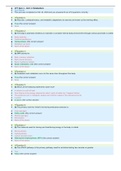Q 3 bmr stands for Study guides, Class notes & Summaries
Looking for the best study guides, study notes and summaries about Q 3 bmr stands for? On this page you'll find 27 study documents about Q 3 bmr stands for.
Page 3 out of 27 results
Sort by
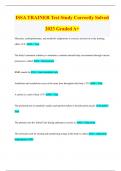
-
ISSA TRAINER Test Study Correctly Solved 2023 Graded A+
- Exam (elaborations) • 25 pages • 2023
-
- $9.99
- + learn more
ISSA TRAINER Test Study Correctly Solved 2023 Graded A+ Muscular, cardiopulmonary, and metabolic adaptations to exercise are known as the training effect. (T/F) ANS-- True The body's automatic tendency to maintain a constant internal body environment through various processes is called: ANS-- Homeostasis BMR stands for ANS-- basal metabolic rate Anabolism and catabolism occur at the same time throughout the body. (T/F) ANS-- True A calorie is a unit of heat. (T/F) ANS-- True ...
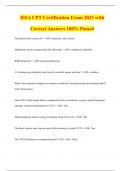
-
ISSA CPT Certification Exam 2023 with Correct Answers 100% Passed
- Exam (elaborations) • 13 pages • 2023
-
- $9.99
- + learn more
ISSA CPT Certification Exam 2023 with Correct Answers 100% Passed The human body consists of? - ANS- chemicals, cells, tissues Metabolism can be categorized in the following? - ANS- catabolism, anabolism BMR Stands for ? - ANS- basal metabolic rate A 30 minute jog would rely most heavily on which energy pathway? - ANS- oxidative What is the automatic tendency to maintain a relatively constant internal environment called? - ANS- homeostasis About 98% of the human body is composed ...

-
ISSA Certified Personal Trainer Quizzes UNIT 1-31 Exam Questions with Correct Answers
- Exam (elaborations) • 39 pages • 2024
- Available in package deal
-
- $18.49
- + learn more
*UNIT 1: METABOLISM* Q 1: Muscular, cardiopulmonary, and metabolic adaptions to excise are know as the Training effect. A. True B. False - ANSWER-A. True Q 2: The body's automatic tendency to maintain a constant internal body environment through various processes is called: A. Body relativity B. Cerebral equilibrium C. Homeostasis D. Metabolic set point E. None of the above - ANSWER-C. Homeostasis Q 3: BMR stands for: A. Basic Memory Retention B. Bad Muscle Recovery C. B...
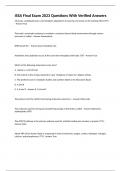
-
ISSA Final Exam 2023 Questions With Verified Answers
- Exam (elaborations) • 25 pages • 2023
-
- $10.99
- + learn more
Muscular, cardiopulmonary, and metabolic adaptations to exercise are known as the training effect (T/F) - Answer True The body's automatic tendency to maintain a constant internal body environment through various processes is called: - Answer Homeostasis BMR stands for: - Answer basal metabolic rate Anabolism and catabolism occur at the same time throughout the body. (T/F) - Answer True Which of the following statements is/are true? A. calorie is a unit of heat. B. One Calorie is ...
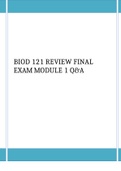
-
BIOD 121 REVIEW FINAL EXAM MODULE 1 Q&A
- Exam (elaborations) • 45 pages • 2023
-
- $18.49
- + learn more
V BIOD 121 REVIEW FINAL EXAM MODULE 1 Q&A BIOD 121 REVIEW FINAL EXAM. MODULE 1 Question 1 5 / 10 pts What is the difference between hunger and appetite? Your Answer: Hunger : sensation that prompts to eat Appetite : a desire to sonsume specific foods. CORRECT ANSERS Hunger is the internal drive to find and eat food. Appetite is the external drive that encourages us to find and eat food . Hunger is related to the negative sensations caused by the lack of f...

-
BSN NSG 3068/NSG 3068 Fundamentals of nursing exam -1 Review 2020
- Other • 24 pages • 2021
-
- $10.49
- + learn more
BSN NSG 3068/NSG 3068 Fundamentals of nursing exam -1 Review Frequently measured vital signs include Temperature Pulse Respiration Blood pressure Oxygen saturation considered as 5 th vital sign Pain considered as 6 th vital sign. Pain is subjective. When are vital signs taken? Admission to hospital, facility, office visit (baseline) Monitor patient condition Identify problems Evaluate response during intervention (before, after, during). Temperature: Temperature rang...

How much did you already spend on Stuvia? Imagine there are plenty more of you out there paying for study notes, but this time YOU are the seller. Ka-ching! Discover all about earning on Stuvia



